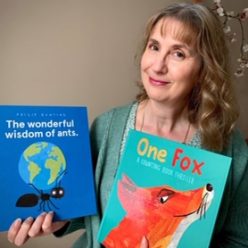Illustrated by Yuval Zommer

Published by Macmillan Children’s Books, 2021
Caterpillars, cocoons, butterflies, and moths. The transformative process of being one thing and becoming something else is one of the miracles of life. And in this story, that’s not the only surprise waiting in store for the reader. Filled with bright, beautiful colours and catchy singsong chanting rhymes, four very different caterpillars discover that what you are today, is not necessarily what you will be all your life!
The star of this story is a dandelion-loving, brown, fluffy, and very ordinary looking woolly bear caterpillar. When the dandelions she loves to eat are pulled up by the gardener, the woolly bear caterpillar must crawl off to search for some new ones.
On the way she encounters a stunning sycamore caterpillar who boasts about her gorgeous coat of red and yellow. A bit further on, there is a vapourer caterpillar proudly showing off tufts of yellow hair all along its purple and red body. Lastly, on the boughs of a towering poplar tree, a puss moth caterpillar sings about the weird, wonderful, and strange red markings covering its face.
Poor woolly bear caterpillar. She has been teased and taunted about her plain brown looks. The other caterpillars are sure that when they become moths, they will be even more beautiful and colourful than they are now.
Distracted by some newly found dandelion leaves, the little woolly bear caterpillar tries to cheer herself up. After all, there is not much you can do to change the way you look, but you can be master of your own thoughts!
Snug in their cocoons, the caterpillars begin their transformation. Some weeks go by, and the moths begin to hatch one by one. The teasing caterpillars have emerged quite plain, but the woolly bear caterpillar is dazzling with her blue spots, stripy body and tiger patterned wings. It’s a vindicating moment and the other moths sing their praises of her!
Julia Donaldson uses wonderful rhythm and rhyme in this story, making it a joy to read. The illustrations are radiant and colourful, complementing the text and enhancing the narrative. There is even a small non-fiction booklet attached to the inside back cover by Michael Blencowe, All About Caterpillars and Moths, which has more information about moths and caterpillars, their body parts and habitats.
I can highly recommend this picture book for children 3-6 years and below are more suggestions for picture books which feature the amazing caterpillar and glorious butterflies and moths:

by Bill Martin Jr.
Illustrated by Lois Ehlert

by Eric Carle

by Scott Tulloch

by Vivian French
Illustrated by Charlotte Voake

by Dianna Hutts Aston
Illustrated by Sylvia Long

by Nicola Davies
Illustrated by Hannah Peck

by Melinda Szymanik
Illustrated by Donovan Bixley

by Lois Ehlert

by Clare Jarrett

by Anna Milbourne
Illustrated by Cathy Shimmen

by Jeanne Willis
Illustrated by Tony Ross

by Ambelin Kwaymullina

by Harriet Evans
Illustrated by Bryony Clarkson

by Martin Jenkins
Illustrated by Hannah Tolson

by Barry Tranter
Illustrated by Emma Tranter

by Stuart Lynch

by Clive McFarland

by Patricia Hegarty
Illustrated by Thomas Elliott

Ordinary Moth
by Karlin Gray
Illustrated by Steliyana Doneva











































































































